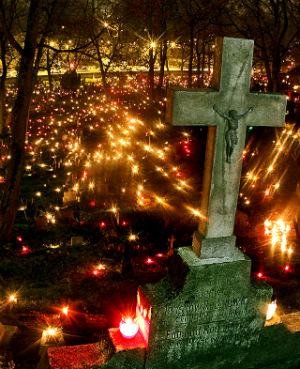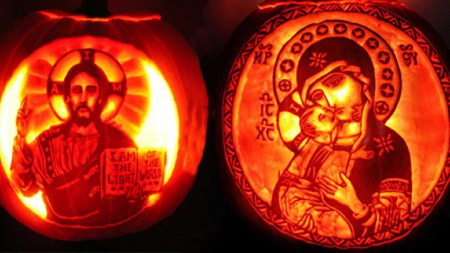We ask you, humbly: don't scroll away.
Hi readers, it seems you use Catholic Online a lot; that's great! It's a little awkward to ask, but we need your help. If you have already donated, we sincerely thank you. We're not salespeople, but we depend on donations averaging $14.76 and fewer than 1% of readers give. If you donate just $5.00, the price of your coffee, Catholic Online School could keep thriving. Thank you.Help Now >
Fraticelli
FREE Catholic Classes
(Or F RATRICELLI )
A name given to various heretical sects which appeared in the fourteenth and fifteenth centuries, principally in Italy. The word being frequently a misnomer, a definition is apposite. Considered philologically, Fraticelli is a diminutive derived from the Italian frate (plural frati ). Frati was a designation of the members of the mendicant orders founded during the thirteenth century, principally the Franciscans or Friars Minor. The Latin Fraterculus does not occur in the old records which concern the Fraticelli. Etymologically the name Friars Minor ( Fratres Minores ) is equivalent to the diminutive Fraticellus . The ideal of the founder of the Friars Minor, St. Francis, was that his disciples by evangelical poverty, complete self-denial, and humility, should lead the world back to Christ. The Italian people designated as Fraticelli all the members of religious, particularly mendicant, orders, and especially solitaries, whether these observed a definite rule or regulated their own lives.
In this article the name Fraticelli is confined to heretical sects which separated from the Franciscan Order on account of the disputes concerning poverty. The Apostolics (Pseudo-Apostles or Apostolic Brethren) are excluded from the category, because admission to the Order of St. Francis was expressly denied to their founder, Segarelli (see A POSTOLICI ). They had no connexion with the Minorites, in fact desired rather to exterminate them. It is therefore necessary to differentiate the various groups of Fraticelli, although the one term may be applied to all.
The origin of the Fraticelli and the cause of their growth within and without the Franciscan Order must be sought in the history of the Spirituals. It must suffice here to note that in consequence of St. Francis's severe requirements concerning the practice of poverty, his followers divided into two branches, the Zelanti, or Spirituals, and the Relaxati, known later as the Conventuals. The popes of the thirteenth century intervened to bring about harmony between the two factions, and Gregory IX , Innocent IV, and Nicholas III gave in their Bulls authoritative explanations of the points at issue. But the differences were not fully adjusted nor was unity ever completely restored between the Spirituals and the main body of the order, the Community ( Fratres de Communitate ).
I.
The group founded by Brother Angelo da Clareno (or da Cingoli) comes first in order of time. Angelo and several brethren from the imprisonment for life, but were liberated by the general of the order, Raimondo Gaufredi (1289-95) and sent to Armenia. Exiled from Armenia towards the end of 1293, they returned to Italy, where in 1294 Celestine V, who was noted for his asceticism, but whose pontificate lasted scarcely six months, willingly permitted them to live as hermits in the strict observance of the Rule of St. Francis . After the abdication of Celestine V, his successor, Boniface VIII, revoked all Celestine's concessions, and they emigrated to Greece, where some of them attacked the legality of the papal action. As the pope, through the Patriarch of Constantinople, caused active measures to be taken against them, they fled to Italy, where their leader, Fra Liberatus, attempted a vindication of their rights, first with Boniface VIII (d. 11 October, 1303), and then with Benedict XI, who also died prematurely (7 July, 1304). On his journey to Clement V (1305-14) at Lyons, Liberatus died (1307), and Angelo da Clareno succeeded to the leadership of the community. He remained in Central Italy until 1311, when he went to Avignon, where he was protected by his patrons Cardinals Giacomo Colonna and Napoleone Orsini. Early in 1317 John XXII, pursuant to a decree of Boniface VIII, declared Angelo excommunicated and placed him in custody. He defended himself ably in his "Epistola Excusatoria", representing himself as a zealous Franciscan, but John XXII refused to admit his plea, Angelo being a Celestine hermit, and in the decree "Sancta Romana et universalis ecclesia" (30 December, 1317) refused to authorize the congregation of which Angelo was head. Angelo submitted temporarily, but in 1318 fled to Central Italy, where, acting as general, he assumed charge of the congregation dissolved by the pope, appointed provincials, ministers, and custodians, established new monasteries, arrogated all authority, issued pastoral letters, and received novices ; in a word, he founded an independent Franciscan Order, the Fraticelli. His adherents professed themselves the original Friars Minor. They denied that John XXII was really pope, as he had abrogated the Rule of St. Francis, which, according to their doctrine, represented the Gospel pure and simple. They asserted that his decrees were invalid, all other religious and prelates were damned, and that the commission of mortal sin deprived priests of the sacerdotal dignity and powers. These views were brought out in the trials to which the imprisoned adherents of Fra Angelo were subjected by the inquisitors, especially in 1334. In the processes of these trials and in numerous papal Bulls they are called, as a rule, Fraticelli seu fratres de paupere vitâ . As appears from the papal Bulls, the followers of Angelo established themselves in Central Italy, i.e., in the province of Rome, Umbria, and the Italy (Campagna, Basilicata, and Naples ). Fra Angelo enjoyed the protection of the Abbot of Subiaco, in spite of the fact that John XXII (21 Feb., 1334) commanded the guardian of the cloister at Ara Cœli to imprison Angelo, "the demented heretic who styles himself general of the condemned sect of the Fraticelli". Equally unsuccessful had been a papal warrant issued for his arrest (22 November, 1331), when he fled to Southern Italy. He died 15 July, 1337, and the congregation, deprived of its leader and hard pressed by the Inquisition, split into a number of groups each holding its own doctrines, though it is impossible to determine exactly their origin. It should further be noted that after the controversy regarding poverty broke out (1321-28), all the Fraticelli showed a stronger opposition to the papacy. It was only natural that men of their calibre and extreme tendencies should fall into excesses; but, schismatics and heretics as they were, the moral lapses of individuals are not to be imputed to the whole body, which after all was but loosely organized. Angelo da Clareno, despite the circumstances of his death, was venerated as a worker of miracles.
Keeping in view the earlier history of the sect, we shall have to seek traces of it in Central Italy, Umbria and the Augustinian Hermits, with whom he was on friendly terms, especially with Gentile da Foligno and Simone da Cassia, an ascetic writer of great repute. He corresponded with both, and Simone bitterly laments in the death of Angelo the loss of a friend and spiritual adviser. We may, therefore, safely assume that the Fraticelli whom Simone afterwards successfully defended against the Dominicans in the civil courts at Florence (c. 1355), where he was then preaching, were adherents of Clareno. The same is probably true, also, of the Fraticelli in Tuscany who about the same time were attacked in the sensational, though neither learned nor skillful, letters of the hermit, Fra Giovanni dalle Celle. The letters were answered by the Fraticelli. Giovanni went even so far as to use Fra Angelo as a pawn against his adversaries. These, indeed, had separated themselves entirely from the Roman Church. They had attained such power in Florence that they invited the "theologians" to public debate. The "theologians", i.e. the official clergy, did not respond. On 13 October, 1378, the priors of Florence enacted a statute against the Fraticelli; on 8 July, 1381, the city council of Florence commanded them to leave the city in two days or face the tribunal of the Inquisition. They were respected so highly, however, that, when their expatriation was demanded by the city magistrates in the same year (14 December, 1381), one of the councillors took a bold stand against the proposal.
Nevertheless, Fra Michele Berti, from Calci near Pisa, a member of the Ancona branch of Fraticelli, after preaching the Lenten course to his associates in Florence, was arrested 20 April, 1389, as he was about to leave the city, and was condemned by the Franciscan Archbishop of Florence, Bartolomeo Oleari, to be burned at the stake. He died chanting the Te Deum , while his followers, unmolested by the authorities, exhorted him to remain steadfast (30 April, 1389). To the end he maintained that John XXII had become a heretic by his four decretals ; that he and his successors had forfeited the papacy, and that no priest supporting them could absolve validly.
We have unmistakable evidence that several heretical followers of Clareno were in the territory of Naples in 1362. Louis of Durazzo, a nephew of Robert, King of Naples, maintained a number of Fraticelli in a hospital adjoining his castle, Monte Sant' Angelo, and attended their services. These Fraticelli were divided into three sects : those acknowledging Tommaso da Bojano, former Bishop of Aquino; the followers of the pretended minister general, Bernard of Sicily ; and those who claimed Angelo da Clareno as their founder and acknowledged only his successor as their general. All three sects agreed in holding that the true papacy had ceased since the alleged heresy of John XXII, but the party of the minister general held it lawful to accept, in case of necessity, the ministrations of priests who adhered to the papacy.
The "Poor Hermits " of Monte della Majella, near Sulmona, were also Fraticelli and adherents of Angelo da Clareno, and at one time afforded protection to the famous tribune of the people, Cola di Rienzi (1349). Fanatical as they were on the subject of poverty, they were, in accordance with ancient custom, sheltered by the Celestine monks in the near-by abbey of Santo Spirito. The origin of the orthodox Clareni, approved as true Franciscans by Sixtus IV in 1474, is unknown; nor is it clear whether they were followers of Angelo who kept aloof from heresy or, after falling into his error, retracted.
II.
The second main group of Fraticelli, chronologically considered, were the Spirituals who fled from Tuscany to Sicily, and were surnamed at first the Rebellious Brothers and Apostates, but later the Fraticelli de paupere vita . It is an error to apply the name Beghards to them. When, in 1309, the differences between the Relaxati and the Spirituals had reached a critical point, Clement V cited representatives of both parties to appear before the Curia with a view to adjusting their disputes. The result of this conference was the Constitution "Exivi de Paradiso", enacted at the final session of the Council of Vienne (6 May, 1312). This Constitution contained an explanation of the Rule of St. Francis along stricter lines than those of the Bull "Exiit qui seminat" of Nicholas III (14 August, 1279), and justified the Spirituals in various matters. This proceeding, however, only provoked the Relaxati superiors to take energetic measures against the Zelanti. Towards the end of 1312 a number of Tuscan Spirituals deserted their monasteries and took forcible possession of the monasteries of Carmignano (near Florence), Arezzo, and Asciano, putting the Relaxati to flight. About fifty, fearing punishment, fled to Sicily. Clement V, hearing of the insurrection, commanded the Archbishop of Genoa and two other bishops to force them to return to obedience under penalty of excommunication. As nearly all disregarded this mandate, the prior of San Fidele at Siena, who had been commissioned to execute it, declared them excommunicated and placed their monasteries under interdict (14 May, 1314). Being also prosecuted by the Archbishop of Florence, the rebels made a solemn protest against the violation of the rule on the part of the Community or Conventuals (7 July, 1313). As it soon became impossible for them to remain in Tuscany, they all fled to Sicily, where they were joined by numerous Zelanti from Northern Italy and Southern France. King Frederick of Sicily, brother of King James II of Aragon, admitted them after they had submitted their statutes to his inspection. Fra Enrico da Ceva was now their leader. On 23 January, 1318, Pope John XXII excommunicated them in the Bull "Gloriosam ecclesiam", specifying five errors, to wit: (1) they designated the Roman Church as carnal and corrupt, and themselves as spiritual; (2) they denied to the Roman priesthood all power and jurisdiction ; (3) they forbade taking an oath ; (4) they taught that priests in the state of sin could not confer the sacraments ; and (5) they asserted that they alone were the true observers of the Gospel. At this time they had adopted a close fitting, short and filthy dress as their religious habit. John XXII (15 March, 1317) admonished King Frederick to take severe measures against them. In a letter of the same date addressed by the cardinals at Avignon to the entire hierarchy of Sicily, special stress was laid on the fact that the rebellious fugitives had elected a superior general, provincials, and guardians. Banished from Sicily, where, however, some remained till at least 1328, they established themselves securely in Naples. On 1 August, 1322, John XXII issued a general decree against them, and after sending King Robert (4 Feb., 1325) the Bulls specially directed against Ceva, on 10 May, 1325, demanded their imprisonment at the hands of King Robert and of Charles, Duke of Calabria. The pope had to repeat this admonition several times (1327, 1330, 1331) to proceed against the Fraticelli and had renewed (5 Dec., 1329) the injunction laid down in the Bull "Gloriosam Ecclesiam". From this time onward the adherents of Ceva are hardly to be distinguished from those of the following group; they joined the Michaelites and used the same methods of attack against the papacy. The statement that some professed Mohammedanism may be based on fact, considering their situation and the local circumstances.
III.
The third group of the Fraticelli are called the Michaelites, deriving their name from Michael of Cesena , their chief representative and natural leader. It must be premised that this name was in vogue during the fifteenth century and that the party it designated exerted great influence in doctrinal matters on the other groups as early as 1329. It is to be noted also that shortly after this period it becomes difficult to differentiate these groups with anything like precision. The "theoretical" controversy about poverty carried on in the Franciscan Order , or rather, carried on against John XXII, gave occasion to the formation of this group. It is called "theoretical" to distinguish it from the "practical" controversy waged by the Spirituals relative to the practice of Franciscan poverty which they wished to observe, whereas the leaders in the present conflict were former members of the Relaxati party and sworn enemies of the Spirituals (1309-22).
In 1321 the Dominican Inquisitor at Norbonne, John of Belna, declared heretical the teaching of an imprisoned Beghard of that region, who asserted that Christ and the Apostles owned nothing either individually or in common. The Franciscan lector, Bérenger Talon, defended the Beghard. As he refused to retract and was threatened with punishment by the inquisitor, Bérenger appealed to the pope. The matter soon developed into a general controversy between the Dominicans and Franciscans ; among the latter, Relaxati and Zelanti alike supported Bérenger on the basis of the Bull of Nicholas III, "Exiit qui seminat". In that Bull Nicholas III had defined the poverty of the Franciscans, both individually and collectively, as equivalent to that of the Apostles, and had therefore transferred to the Roman Church all their holdings in land and houses, as had already been enacted by Innocent IV (14 Nov., 1245). The prohibition of Nicholas III to discuss this point was revoked by John XXII in a new Bull, "Quia nonnunquam" (26 March, 1322). On 6 March of the same year John XXII had submitted the matter to a consistory. The order was vigorously defended by the Cardinals Vitalis du Four and Bertrand de Turre (de la Tour), Archbishop Arnaldo Royardi of Salerno, and various other bishops, all Franciscans ; other cardinals opposed their views, and the pope leaned towards the opposition. He also requested the opinion of Ubertino of Casale, a renowned Spiritual leader (1328), who, with a fine-spun distinction, declared (28 March, 1322) that Christ and the Apostles did possess property, inasmuch as they governed the Church, but not as individuals or as exemplars of Christian perfection. This distinction, more subtle than real, seemed satisfactory to both sides, when the provocative measures taken by the chapter of the order destroyed all prospects of peace. Fra Michael of Cesena, General of the Franciscan Order (elected 1316), a Conventual, as attested by various measures enacted by him with the approval of John XXII, convened a general chapter for 1 June, 1322, at Perugia. Anticipating, on the advice of the Franciscan Cardinals Vitalis and Bertrand, the definitive decision of the pope, the chapter solemnly declared in favour of the "absolute poverty" of Christ (4 June, 1322). This pronunciamento was signed by the general, Michael of Cesena, the provincial ministers of Southern Germany, England (William of Nottingham, not Occam), Aquitania, Northern France, and others, as well as by several renowned scholars. On 11 June the chapter solemnly published its decrees to all Christendom. Indignant at these proceedings, John XXII, in the Bull "Ad conditorem canonum" (8 December, 1322), declared that the Roman Church renounced all its claims to the movable and immovable properties of the Franciscan Order and therewith returned them. thus the pope revoked the Bull "Exiit" of Nicholas III and did away with the poverty which formed the basis of the Franciscan Order. It is easy to understand the effect of this upon the Franciscans, particularly the Zelanti. In the name of the order Fra Boncortese (Bonagrazia) of Bergamo, a capable lawyer and up to that time a bitter enemy of the Zelanti, presented a daring protest against this Bull to the Consistory (14 January, 1323). Although the pope thereupon revised the text of the Bull and reissued it under the original date, he incarcerated Bonagrazia and in the Bull "Cum inter nonnullos" (12 November, 1323) declared heretical the assertion that Christ and the Apostles possessed no property either separately or collectively.
The controversy between the pope and the order soon took on a political character, the Minorites having been appointed counsellors to Louis IV the Bavarian, King of Germany, who also was engaged in a conflict with the pope. After Louis IV (1314-47) had defeated his rival Frederick, Duke of Austria, at the battle of Mühldorf (18 Sept., 1322), and had invaded Lombardy to further the cause of the Ghibelline Visconti, John XXII ordered the whole question of right to the German throne to be brought before the papal tribunal and, on 8 October, 1323, began canonical proceedings against Louis. In the Nuremberg Appeal (18 Dec., 1323) Louis, curiously enough, had accused the pope of unduly favouring the Minorites, though this document was never published. But the Sachsenhausen Appeal of the same King Louis (22 May, 1324) was full of invectives against the " heretic who falsely designates himself Pope John XXII " for doing away with the poverty of Christ. This famous "Spiritualist excursus" is closely connected with the Appeal of Bonagrazia, and with writings of Ubertino of Casale and of Pietro di Giovanni Olivi. It is certain that it originated among the Franciscans who, under the protection of the king, aimed it at John XXII and his teaching, although Louis IV later denied all responsibility in the matter. The result was that Louis IV was excommunicated (11 July, 1324) and, in the decree "Quia quorundam" (10 Nov., 1324), John XXII forbade all contradiction and questioning of his constitutions "Cum inter nonnullos" and "Ad conditorem". The general chapter of the order, assembled at Lyons (20 May, 1325) under the presidency of Michael of Cesena , forbade any disrespectful reference to the pope. On 8 June, 1327, Michael received instructions to present himself at Avignon, a command which he obeyed (2 Dec., 1327). The pope having sharply reproved him in public (9 April, 1328) for the chapter's action at Perugia (1322), he drew up a secret protest (13 April) and, fearing punishment, fled, despite the orders of the pope, to Aigues-Mortes (28 May) and thence to Pisa, together with Bonagrazia of Bergamo and William of Occam. In the meanwhile other events of importance had occurred. Louis the Bavarian had entered Rome with a German army, to the great joy of the Ghibellines. Accompanying him were Ubertino of Casale, John of Jandum and Marsilius of Padua, the authors of the "Defensor pacis", which declared that the emperor and the Church at large were above the pope. Louis had himself solemnly crowned Emperor of Rome by Sciarra Colonna (17 Jan., 1328), and on 12 May he nominated and had consecrated as antipope Pietro Rainalducci of Corvara, a Franciscan, under the name of Nicholas V. The three fugitives from Avignon presented themselves to Louis and accompanied him to Bavaria, where they remained till their death. John XXIIdeposed Michael as general of the order (6 June, 1328) and (13 June) appointed the Minorite Cardinal Bertrand de Turre vicar-general of the order to preside at the chapter to be held in Paris (2 June, 1329), which Michael of Cesena vainly attempted to prevent, and brought about the election of Fra Gerardus Odonis of Châteauroux, of the province of Aquitaine. Obedient to John XXII, he induced the majority of the order to submit to the Apostolic See . Michael of Cesena and all his adherents, the Michaelites, were repudiated by the order. At the same time, by command of John XXII , papal proceedings were instituted against them everywhere. The Michaelites denied John's right to the papacy and denounced both him and his successors as heretics. This shows the dangerous character of the sect. In their numerous and passionate denunciations of the popes, especially of John XXII, they always single out for refutation isolated statements of John in his Bulls. To the contention regarding poverty was added (1333) the question of the beatific vision of the saints, concerning which John XXII, contrary to general opinion, yet without intending to define the matter, had declared that it would begin only at the last judgment.
During this period the antipope, Nicholas V, had nominated six cardinals (15 May, 1238), among them an Augustinian and a Dominican, and between September, 1328, and December, 1329, three other cardinals ; also among the bishops whom he consecrated were members of the two orders mentioned above. After Louis IV had returned to Bavaria, Nicholas V, deprived of all support, took refuge with the Count of Donoratico. Finally, in his distress, Nicholas appealed to John XXII, cast himself at his feet ( Avignon, 4 Aug.), and submitted to honourable confinement at Avignon, where he remained till his death (16 October, 1333).
John, meanwhile, had taken steps against Michael and his followers. In accordance with his instructions (20 June, 1328) to Aycardo, Archbishop of Milan, the proceedings against Michael were published in various localities. On 5 September, 1328, John XXII commanded the imprisonment of Fra Azzolino, who was acting as Michael's vicar, and on 18 August, 1331, the arrest of another vicar, Fra Thedino, who represented Michael in the Minorites in the monasteries of Todi and Amelia (against whom proceedings were instituted in 1329-30), of Cortona (1329), and of Pisa (1330), where, however, they appeared openly as late as 1354, and at Albigano, and Savonna (1329-32).
On 21 Dec., 1328, John XXII graciously pardoned Fra Minus, the Provincial of Tuscany, while on 2 Dec., he had ordered the trial of Fra Humilis, Custodian of Umbria. Papal decrees reveal the presence of Michaelites in England (1329), Germany (1322), Carcassone, Portugal (1330), Spain (1329), Sicily and Lombardy (1329, 1334), Sardinia, Armenia, and other places. John XXII and his immediate successors also issued numerous decrees against the Fraticelli in the bishops and minor feudal barons defended them stubbornly and succesfully in spite of papal threats; also in Naples and Calabria, where King Robert and Queen Sanzia exhibited special veneration for St. Francis and his humble followers. In the royal castle, where the chaplaincies were held by Franciscans, there resided Fra Philip of Majorca, a brother of the queen. This Philip had (1328) petitioned John XXII for permission for himself and other Franciscans to observe literally the Rule of St. Francis , independently of the superiors of the order; the pope of course refused. In a letter dated 10 August, 1333, the pope was obliged to settle some doubts of the queen relating to the observance of "holy poverty", and the king had even composed a treatise favouring the views of the Chapter of Perugia (1322). The papal condemnations of the Fraticelli, therefore, had produced but slight results in the Kingdom of Naples. On 8 July, 1331, the pope admonished King Robert to withhold no longer the papal decrees against Michael of Cesena nor prevent their publication in his kingdom. Philip of Majorca, however, preached openly against the pope. It was due to the influence of the royal family that Fra Andrea of Galiano, a court chaplain at Naples, was acquitted in the process instituted against him at Avignon in 1338, as he still continued his intercourse with Michael of Cesena and with the fifty Michaelites who resided for some time under the king's protection in the castle of Lettere near Castellamare, but who later (1235) humbly submitted to their lawful superiors. In 1336 "short-robed" Fraticelli still occupied the monastery of Santa Chiara at Naples, founded by Queen Sanzia, and were established in other parts of the kingdom; their expulsion was demanded (24 June, 1336) by Benedict XII (1334-42). In 1344 Clement VI (1342-52) found it necessary to reiterate the earlier decrees. Between 1363-1370 it at last became possible for Franciscans to take possession of several monasteries in Calabria and Sicily from which the Fraticelli had been expelled; but Gregory XI complains (12 Sept., 1372) that the "ashes and bones of Fraticelli were venerated as relics of saints in Sicily, and churches were even erected in their honour ".
From the records of a process (1334) conducted in irregular form against the Fraticelli of the Franciscan monastery at Tauris, who had been reported by Dominicans, we learn that they inveighed openly against John XXII and upheld the views of Michael of Cesena, although in their apocalyptic manner they declared that the order of the Friars Minor was divided in three parts, and that only those would be saved who would journey to the East, i.e. themselves. It is uncertain whether these were identical with the Fraticelli in Armenia, Persia, and other oriental localities, where all bishops were commanded by Clement VI to prosecute them (29 May, 1344).
For a long time the sect prospered exceedingly in the Duchy of Spoleto on account of the continual political turmoil. In a process instituted against a particular Umbrian group of Fraticelli in 1360, we are informed that Fra Francesco Niccolò of Perugia was their founder. They pretended to observe the Rule of St. Augustine , but were fanatical on the question of poverty and regarded all prelates as guilty of simony. Salvation was to be found only in their, supposedly perfect, order. They imitated the Sicilian Fraticelli in their doctrines and methods of instruction. An interesting letter is still extant which the Fraticelli of the Campagna (1353-55) wrote to the magistrates of Narni when they heard that one of their number (Fra Stefano) had been cruelly imprisoned by the Inquisition of that city twelve or fifteen years before. In this letter they petitioned the magistrates to liberate him according to the example of the cities of "Todi, Perugia, Assisi, and Pisa ".
The Fraticelli enjoyed complete liberty in Perugia. They lived where it best suited them, principally in the country-houses of the rich. They became so bold as to publicly insult the Minorites (Conventuals) in the monastery of San Francesco al Prato. It appears that these Fraticelli had elected their own popes, bishops and generals, and that they were split into various factions. The Conventuals, as their one means of defence, called in Fra Paoluccio of Trinci, the founder of the Observants, and ceded to him the small monastery on Monte Ripido near the city (1374). Fra Paoluccio was successful in his disputations with the Fraticelli, and when they had been clearly exposed as heretics, the people drove them from the city. It should be noted that these Fraticelli, and probably all the others of that period, were designated Fraticelli della opinione, perhaps on account of their opinion that the Roman papacy had ceased to exist with John XXII (1323) or Celestin V, and that they alone constituted the true Church. About this time Fra Vitale di Francia and Fra Pietro da Firenze exercised a sort of generalship over the Fraticelli. They received protection and hospitality from rich and influential families in Apulia, around Rome, and in the March. One of their protectors was the kinght Andreuccio de Palumbario, who sheltered them in his castle near Rieti, for which he was sharply called to account by Urban VI (4 May, 1388). On the same day the Benedictine Abbot of Farfa was reprimanded for a similar fault. On 14 November, 1394, Boniface IX empowered the Minorites of Terra di Lavoro to take possession of the monasteries deserted by the Fraticelli. Martin V conceded the same rights to the Franciscans of the Roman Province (14 November, 1418) and, on 7 April, 1426, transferred to them as a special grant the monastery of Palestrina, which had been a stronghold of the Fraticelli. In the same year Martin V nominated St. John Capistran (27 May) and St. James of the March (11 October) as inquisitors general to take action against the Fraticelli. These promoters of order among the Franciscans fulfilled the duties of their office strictly and energetically and succeeded in striking at the very vitals of the sect. In 1415 the city of Florence had formally banished the "Fraticelli of the poor life, the followers of Michelino of Cesena of infamous memory ", and in Lucca five Fraticelli, on trial, had solemnly abjured their error (1411). Martin V also ordered the Bishops of Porto and Alba to take steps against all Fraticelli "in the Roman province, the Spoleto and other localities" (7 June, 1427). On 27 January of the same year, Martin V had permitted the Observants of Ancona to occupy the monastery of the Fraticelli at Castro l'Ermita as a first step in the campaign against the Fraticelli of that neighbourhood. On 1 June, 1428, he commanded the Bishop of Ancona to enforce his rulings strictly in Maiolati, to put all suspects to the rack, destroy their village, separate the children from heretical parents, and disperse the elder population. A circular letter, which the Fraticelli addressed to all Christiandom, proved ineffectual and their doom was sealed. John of Capistrano and James of the March burned thirty-six of their establishments or dispersed the members and a number were burned at the stake at Florence and Fabriano, at the latter place in the presence of the pope. St. James of March, commissioned by Nicholas V to proceed against them (1449), wrote the famous "Dialogus contra Fraticellos", which he first published in 1452, making some additions to it later on. According to this the main establishments of the Fraticelli were situated in the valley of Jesi, at Maiolati, Poggio Cupo, Massaccia, and Mergo. They had also constituted bishops in other districts where there were a sufficient number of adherents. They made frequent journeys for propaganda purposes, especially in Tuscany. Some dressed partly as Minorites, some as hermits, often disguising themselves for the sake of protection. Their doctrine was a résumé of their former sectarian errors : the whole Roman Church had deserted the true Faith since the time of John XXII (1323); they alone constituted the true Church and retained the sacraments and the priesthood.
A form of Fraticelli was also represented by Philip of Berbegni, a fanatical and eccentric Observant of Spain (1433), who attempted to establish a strict society de la Capuciola, but met vigorous opposition from John Capistran, who issued a dissertation against him.
Only once again are measures known to have been taken against the Fraticelli, viz., in 1466, when a number of Fraticelli from Poli, near Palestrina, and Maiolati were captured at Assisi during the Portiuncula celebration. They were imprisoned in the castle of Sant' Angelo and proceedings instituted against them. Their protector at Poli, Count Stefano de' Conti, was imprisoned, but they also received the protection of the Colonna family of Palestrina. Tradition also mentions that the Fraticelli established many other colonies and that they had an important centre in Greece, whence they sent out emissaries and where they sought refuge from the aggressive measures of St. James of the March. They generally held their reunions at night in private houses and half of the inhabitants of Poli are said to have been among their adherents. The allegation that their religious services were defiled by immoral practices cannot be proved. According to their doctrine, as contained in the "Dialogus", immoral priests incurred the loss of the powers of order and jurisdiction. They had also their own bishop, Nicholas by name.
During this period numerous pamphlets were published controverting the errors of the Fraticelli. While the campaign was going on at Rome, information was brought concerning another sect similar to the Fraticelli, which had been discovered in Germany ; but though these visionaries, led by Brothers Johann and Livin of Wirsberg, found adherents among the Mendicants in Bohemia and Franconia, they cannot be considered as Fraticelli. In spite of all persecutions, remnants of the original Fraticelli still survived, but their strength was crippled and they thenceforth constituted no serious danger to the Roman Church. The foregoing sketch sufficiently proves that these heretics were not members of the Order of St. Francis, but rather that they had been expelled from the order and from the Church. The order as such and in the great majority of its members remained faithful to the Church in spite of the fact that many prominent monks and even whole sections fell away.
Join the Movement
When you sign up below, you don't just join an email list - you're joining an entire movement for Free world class Catholic education.
-

-
Mysteries of the Rosary
-
St. Faustina Kowalska
-
Litany of the Blessed Virgin Mary
-
Saint of the Day for Wednesday, Oct 4th, 2023
-
Popular Saints
-
St. Francis of Assisi
-
Bible
-
Female / Women Saints
-
7 Morning Prayers you need to get your day started with God
-
Litany of the Blessed Virgin Mary
All Saints' Day, Halloween and All Souls' Day: What's the difference?
-

Should Christians Celebrate Halloween?
-

Since when did Halloween become a Christian holiday?
-
ADORABLE: A Little Boy's Heartfelt Lunchtime Prayer
-
Scientists Decode 3,000-Year-Old Babylonian Tablet, Revealing Potential Location of Noah's Ark
Daily Catholic
 Daily Readings for Friday, November 01, 2024
Daily Readings for Friday, November 01, 2024 St. Valentine Berrio-Ochoa: Saint of the Day for Friday, November 01, 2024
St. Valentine Berrio-Ochoa: Saint of the Day for Friday, November 01, 2024 Litany of the Saints: Prayer of the Day for Friday, November 01, 2024
Litany of the Saints: Prayer of the Day for Friday, November 01, 2024- Daily Readings for Thursday, October 31, 2024
- St. Wolfgang: Saint of the Day for Thursday, October 31, 2024
- Memorare: Prayer of the Day for Thursday, October 31, 2024
![]()
Copyright 2024 Catholic Online. All materials contained on this site, whether written, audible or visual are the exclusive property of Catholic Online and are protected under U.S. and International copyright laws, © Copyright 2024 Catholic Online. Any unauthorized use, without prior written consent of Catholic Online is strictly forbidden and prohibited.
Catholic Online is a Project of Your Catholic Voice Foundation, a Not-for-Profit Corporation. Your Catholic Voice Foundation has been granted a recognition of tax exemption under Section 501(c)(3) of the Internal Revenue Code. Federal Tax Identification Number: 81-0596847. Your gift is tax-deductible as allowed by law.













 Daily Readings for Friday, November 01, 2024
Daily Readings for Friday, November 01, 2024 St. Valentine Berrio-Ochoa: Saint of the Day for Friday, November 01, 2024
St. Valentine Berrio-Ochoa: Saint of the Day for Friday, November 01, 2024 Litany of the Saints: Prayer of the Day for Friday, November 01, 2024
Litany of the Saints: Prayer of the Day for Friday, November 01, 2024
